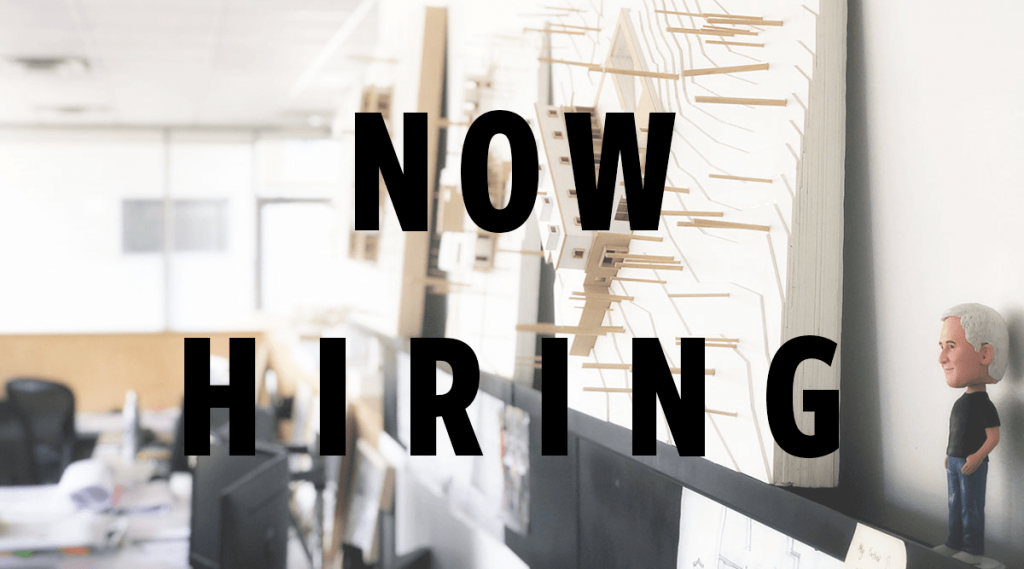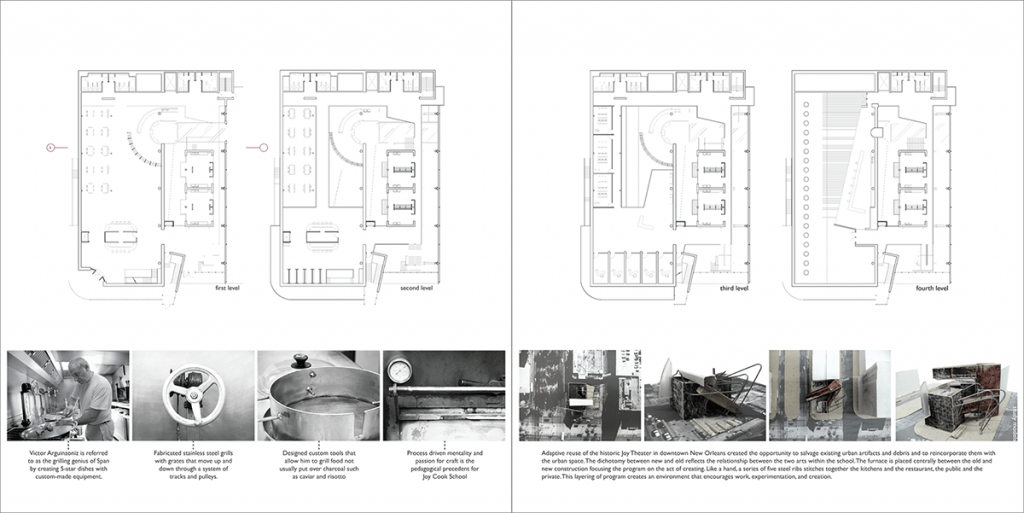Getting a job in an architect’s office should be a lot easier than it really is … well, I should put a caveat on that statement to say that it’s hard to get a good job in a good architect’s office. Including mine.
The reason this particular topic is on my mind is that I am looking to hire a few people, but we’ll get to that in a minute. Since we are just a few months out from shiny new graduates knocking on my door looking for work, I thought I would discuss how this process works, the sort of things I look for, and who knows, maybe you and I could be working together.
…more on that towards the end.

Probably the hardest part about getting a job in an architect’s office is simply getting your foot in the door. I can tell you that we haven’t had the need to solicit for a new employee in years … which is not the same thing as not needing to hire someone. The last three people who have joined our staff were all people that we already knew or came recommended to us from people we trusted. I receive on average around 10 resumes a month from people looking for a job – which is a lot for an office that currently only has 9 employees. So how does someone get their foot in the door? The easiest way is to know someone who can make the introduction. Another fairly painless way to set up those initial interviews is to talk to your friends that already have jobs and let them know that you are looking, chances are pretty good that they’ll say something to their office and if there’s a need, you’ll probably get a call. The last way, which is not coincidentally the one with the poorest odds for success, is to send out emails expressing interest in the firm and requesting an interview. Of the estimated 1,200 unsolicited resumes I’ve received via email over the last 10 years, not once has someone received a job offer. I’ve come close a few times but as I said, the odds are not in your favor.
First up is a quick chat about cover letters and resumes. If you have to make your initial contact through email, you need to have some sort of cover letter. These should be fairly short and to the point (even though I already know the point – you want a job). The very first thing you have to do is figure out to whom you need to address this cover letter – which is basically your email since nobody is actually mailing out their resumes and portfolios. This is important and if you get this next part wrong I will not continue reading your email … Do NOT address your cover letter to “Dear Sir/Madam”
I’ve actually written an entire article about this singular error – the aptly titled Emailing Your Resume – Fatal Errors and this post has all of my hot buttons in them. I consider this problem-solving 101 and if you can’t figure out how to take this first step then you are not a good fit for my office. I get it that you might have to go through some sort of job portal at the larger firms when submitting your qualifications. In those moments when you can’t determine who might be looking at your resume, you could simply write “Greetings” and go about your business.
Everyone should have a resume – this is the first document that someone like me will pay attention to – it’s the thing that will compel me to either open your portfolio or move on to the next candidate. Sounds harsh (even as I write it I know what it sounds like) but in a firm like mine, communication skills are important and how you write your cover letter and assemble your resume tell me a lot about you and how you think. Back in May 2011 I wrote Writing Your Resumé with the idea that I would tell people all the “what not to do’s” and the other nuances that exist within resumes. With just a pinch of additional effort, your resume contains all the information you want to plant between the lines to tell someone like me a little something extra about you.
So let’s say your timing is fantastic and you’ve managed to get a job interview … Congratulations! What sort of things do you need to bring with you? If this is your first job coming out of school, you will need to bring your portfolio along. If you have been out of school for a bit, I would definitely bring along some examples of the professional work you’ve been doing. While your school portfolio is important, since you’ve been out of school for a bit I can learn more about your current skill set by looking at the sort of tasks you’ve been given at your last (or present) job. This would include construction drawing sets and graphics packages you might have created. You should still have your portfolio handy but it’s possible that I probably won’t spend too much time looking through it other than to see what your skill level was coming out of school and how things have progressed for you since.

Let’s take just a minute to talk about portfolio’s, shall we? I wrote the article Architectural Portfolios almost two years ago and in that time, it has become my go-to article whenever questions related to portfolios comes up. If you haven’t read it and you have questions, read it before asking me because chances are good I’ve already addressed your question. Portfolios have a diminishing value to them the further removed from school you become – I don’t even think I brought mine with me after my second or third job. The most important piece of information in that post is that your portfolio is simply another design problem that you’ve been asked to solve. The content should be curated for the story you want to tell and the job you wish to acquire.
The last few pieces of advice I have for those folks looking to get the architectural job of their dreams has to do with how you carry yourself in the actual interview. First off, feel free to over-dress, it’s way better than showing up under-dressed. When I was younger and still making the rounds I always wore a dark suit and a freshly pressed shirt without a tie to my interviews. I would say I had about a 50/50 chance that the person I was meeting with was going to be wearing a tie and considering that I received a job offer from every interview I ever went on, the missing tie wasn’t a problem.

During the interview itself, you need to be prepared to do your part carrying the conversation. It isn’t just your answers to questions that are important; it’s also how you respond. Attitude can solve far more perceived ills than ability during an interview. Since I can’t truly evaluate your abilities during our conversation, I am dialing in on how you are presenting yourself. Some typical questions you should expect to hear include:
Why do you want to work here?
Why did you leave your last job?
What do you think is your best skill?
What are your goals for working here?
What are your expectations for this job?
How much money do you expect to make?
I am amazed at how many people who have come in for a job interview don’t ask questions to the people who are interviewing them. That would be a major strike against you in my evaluation. Not asking questions of your potential employer sends a message that you either 1) don’t have options, 2) don’t care as long as you get a job, 3) didn’t think ahead and aren’t prepared, or 4) you are task oriented rather than goal oriented. Take your pick, they are all bad. In every job interview I ever went on, I always asked very specific questions. Some of my typical questions might have included:
What will my role be?
What needs are they trying to fill with me?
What are my opportunities for advancement?
What skill sets would they like to see me develop?
How long did their employees stay with them?
That’s not too bad, is it? All of these questions seem to be fairly obvious to me and if you have your act together, this should be your starting line. There are all sorts of other questions that might come up, some of which depend a little on how far along you are in your career and the sort of job you are hoping to acquire.
I told you all the above information because if you would like to work in my office, located centrally in the land of milk and honey, this is your chance because we need to add a few more people to our staff. Here is the official description:
We are currently looking to add at least two people to our current staff – one person with 3-5 years of experience and one with 0-1 years experience. Our projects are a fairly even mix of residential, light commercial, and corporate architectural interiors so the chances of you becoming bored are rather remote. Most of where my time is spent is on the residential and light commercial side – although, I tend to work a bit on everything since part of my job involves making sure people understand gravity and that water (and other fluids) run downhill.
Our employees typically get slightly more responsibility than they can handle; which creates a pretty invigorating and exciting atmosphere. We are an office full of problem solvers and being self-motivated and a good problem solver is paramount to finding success in our office. We tend to manage our employees the way we like to be managed – just tell me what needs to be done and let me go do it.
Everyone in our office has an architectural education and is licensed or currently taking the exams. There are good reasons to get your license and we make it a big deal. We don’t bill our clients based on the percentage of construction cost; we bill hourly since we sell time and experience. That means we charge more for licensed individuals than non-licensed individuals, and our employee’s salary generally reflects their billing value … but for now, I will say that the salary is commensurate with ability. We have full insurance benefits, savings plan with matching employer contributions, and we have historically given a Christmas bonus every year that we have been in business. Even in the crap years.
I will tell you that communication skills are really, really important in this office. We like to put our employees in front of clients and contractors and the ability to speak with clarity and intelligence is a plus. If you are the sort that enjoys talking to others, this is the place for you.
We are also on permanent summer hours here at MMB Architects which means we work 9 hour days Monday through Thursday, then leave at noon on Friday’s (unless you have client meetings … and it seems that I always have client meetings). I tend to come into the office early (7:00 am) and leave at 6:00 pm so I can get home and spend time with my family whereas the single kids come in a bit later and stay later … apparently, they go to raves and drink beer afterward. As much as I like to go to work and design cool stuff, we try to set a corporate culture around the office that people don’t have to give up everything in order to be an architect. I rather like it when our employees have outside interests because it shapes them into more rounded individuals. I strongly believe that the creative process of design and that practicing architecture demands your knowledge and understanding of what it means to be a complete and fully functioning member of society.
We cover all AIA fees and dues, and if you are licensed, we pay for you to attend 1 conference a year (Texas Society of Architects Convention or the Texas Society of Architects Design Conference). In addition to covering registration fees, you get time off from work to attend … this is not a “use your vacation” arrangement – nor do we expect you to make up your time.
This is a great place to work and for someone who is smart and self-motivated – you will get to do just about anything you want and you won’t be trapped in the office all the time behind your computer.
We pay well but we consider all these other benefits part of the compensation package here – that along with the fact that this is a pleasant place to spend your days.
Think you might want to work in my office on one or two of my projects? I am dying and will confess that I have received 45 emails just today that required immediate action … and I need some help. We have some amazing projects in the office (residential, architectural interiors, hotel, medical clinic, retail – we’ve got it all) and if you are the right person, we would like to have you join us. All you have to do is send me a cover letter and your resume – which should be easy because I just spent this entire post telling you exactly how to do it. If you want me to tell you where to send it, I am going to let you figure that one out for yourself – consider it your first problem-solving test.




